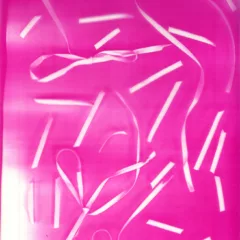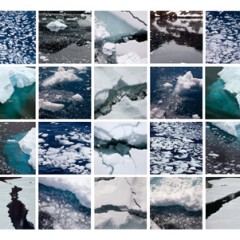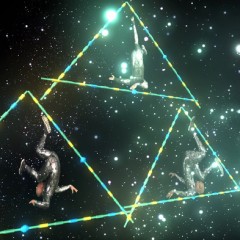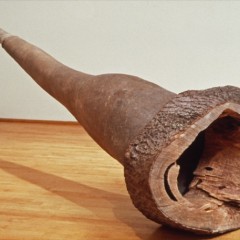Post by Andrea Kirsh

One part of Grotto, by Richard Torchia, a two-part camera obscura installation at Slought Foundation
I was at the opening last night at Slought Foundation of Richard Torchia’s camera obscura installation “Grotto” and George Quasha’s “Zero Point Axis,” an exhibition of drawings and sculpture.
Quasha’s works are awesome – in the literal meaning of the word: work that stops you in your tracks, and makes you realize how much we take for granted. Gravity, balance; these are not insignificant forces. As with all good sculpture they make you aware of your own physicality and embodied-ness. They are made of found pieces of stone, unaltered by the artist, but improbably balanced upon one another–sort of miniature, organic variants of Serra’s prop pieces. But that comment doesn’t do them justice. From their description on Slought’s website I was entirely unprepared for the effect they would have.
Torchia’s installation in the front room consists of two parts: one focused outwards at Walnut Street; the other transforms Slought’s plumbing into the most amazing fountain, one with the water slowly dripping upwards, courtesy of the lens’ inverted view. Both of them seem to move at a pace slower than life, although that makes no sense, of course. Their imagery is life, in real time, something that usually needs editing to catch our interest, and that is what Torchia’s art provides.
The artists spoke for the gathered crowd, introduced by Osvaldo Romberg, who said he considered the two bodies of work to be one exhibition. He asked the artists why they thought he had chosen to exhibit them together. Torchia suggested that both produced “art without art.” Quasha later said he was not interested in the “honorific” designation of “art” to describe his practice. He considers his finding the axes of the stones as a communication with them; only later might the results become art. Romberg was particularly happy to have an exhibition that could be appreciated by anyone, regardless of their exposure to the art world. He’s right. It’s the rare exhibition of contemporary art that I will take my husband to; Andrew has extensive knowledge of art, but his interests favor the sixteenth to eighteenth centuries.
Both artists and their work remind me of a wonderful experience I had, years ago, driving to the Neuberger Museum with an artist friend and her daughter, Maya, who couldn’t have been older than three. Whenever we passed anything that showed signs of human intervention, even telephone poles or piles of trash, Maya would ask, with the enthusiasm of a young child, “Is it art?” Torchia and Quasha share her enthusiasm and wonder at the world.
–Andrea Kirsh is an art historian based in Philadelphia. You can read her newest Philadelphia Introductions and other commentary at InLiquid.









